A Financial Analysis of Public Funds Invested via ESAs, Vouchers and Tax Scholarships
This real-time financial analysis tracks state funding going into private options, to quantify how many public dollars are flowing through ESAs, vouchers, and tax credit scholarships. FY23-24 and FY 24-25 analyses available.
30-Min Webinar: Can academic recovery continue when federal relief funds dry up?

We look at public education spending and outcomes over a decade, nationally and state by state, plus what the likely revenue trajectory could mean for future math and reading scores.
With a Fiscal Cliff Looming, States Must Ensure Districts Maximize Every Dollar for Students
These five levers are low-cost and popular on both sides of the aisle.
State Revenues Outlook
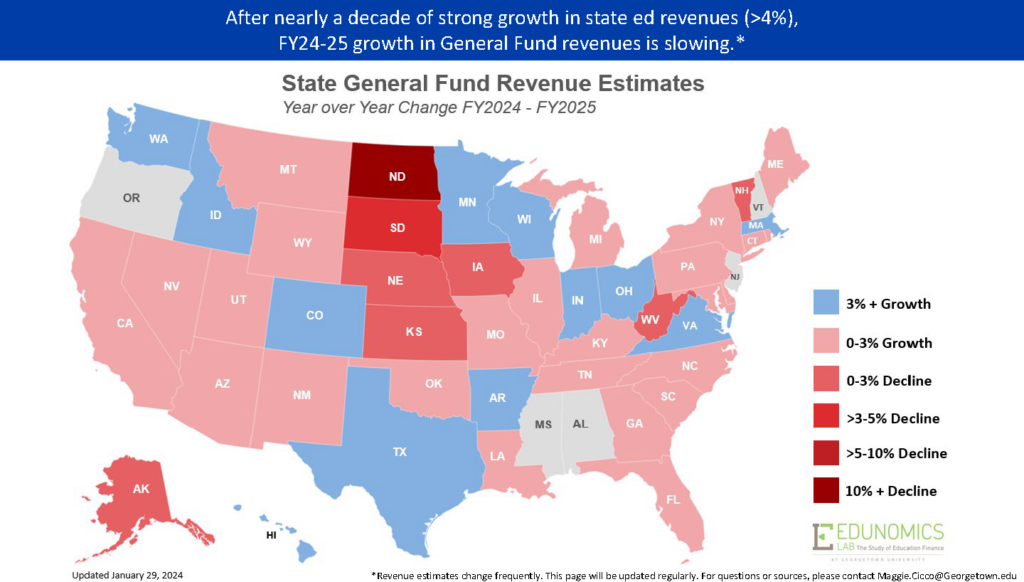
This analysis provides estimates of year-over-year changes to state General Fund revenues.
How legislatures can ensure school funds do more for students
K-12 funding is the biggest line item in most state budgets. Here are five policy levers that states can pull to help districts maximize the value of every dollar for students.
30-Min Webinar: The ESSER Cliff: What state and district leaders in CT, MA, NH & RI should know as ESSER funding ends

This webinar shares an analysis of the pending ESSER cliff in districts in 4 New England states and key factors in protecting what matters most for students & district financial health.
Where and how does inequity creep in?

Marguerite Roza gave this presentation as part of panel on “Understanding Educational Opportunity Gaps,” at the University of Virginia School of Law’s launch of the Education Rights Institute.
4 Ways State Leaders Can Lower Teacher Pension Costs

State and district leaders could simultaneously reduce retirement costs and improve benefits for teachers, writes Chad Aldeman.
Opinion: The N.Y. Legislature’s big class size mistake

In this New York Daily News op ed, Chad Aldeman argues that across-the-board class size caps in New York City may not benefit all students and will limit other spending that might be more effective, for example on extracurriculars or counselors or higher salaries for teachers.
Existing Federal Provisions Can – If Given Appropriate Attention – Advance Within-District Financial Equity

Four existing federal provisions have potential, if made a priority, to work together to foster within-district financial equity, write Marguerite Roza and Hannah Jarmolowski.
Desired Features of a State Funding System

This decision tree describes the desired features of a state education funding formula and walks policymakers through key decisions and considerations around balancing efficiency, equity and trade-offs in particular contexts.
Proceed with caution: With enrollment drops, states are looking to hold district budgets harmless

In this brief, Hannah Jarmolowski and Marguerite Roza outline what states need to weigh when it comes to hold harmless provisions.
School Finance for Equity and Innovation
On December 9, 2020 Marguerite Roza participated in California Charter Schools Association’s 2020 Education Symposium. She discussed leveraging data to lead efforts to improve equity and productivity, and how leaders can enable systems to navigate the financial turmoil ahead.
Analysis: California Gives Districts Extra Money for Highest-Needs Students. But It Doesn’t Always Get to the Highest-Needs Schools

In this analysis, Katie Silberstein and Marguerite Roza studied whether funds allocated by California’s Local Control Funding Formula actually made it to the highest-needs schools.
When it Comes to School Funds, Hold-Harmless Provisions Aren’t “Harmless”
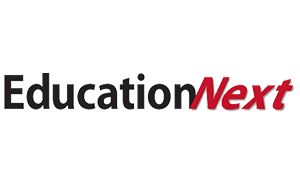
In this Education Next article, Marguerite Roza and Hannah Jarmolowski share how state leaders can address budget shortfalls without making disproportionate cuts to high-poverty districts.
How Lawmakers Can Raise Teacher Pay Without Decimating Pension Funds

In this op-ed, Marguerite Roza analyzes how making any near-term teacher raises non-pensionable could impact state governments and K-12 teachers and students.
Could states save money if raises during a recession were designated as non-pensionable?

This brief examines how making raises non-pensionable would impact teacher pensions and government pension debt.
How States Can Put Students at the Center of Their School Funding Formulas

In this Hunt Institute “Making Sense of NC School Funding” blog, Marguerite Roza provides a national perspective on how states approach school funding.
Leaders Ignored Teacher Pension Debt. Now There’s Less Money for Teacher Salaries and Students

This brief quantifies, in per pupil and per teacher terms, the magnitude of the crowd-out that pension debt creates for six states: CA, IL, LA, SC, TX, and VT. The goal is to help education leaders grasp the relationship between their pension debt bills and their aspirations for spending on schooling inputs, including teacher salaries.
Funding for Students’ Sake: How to Stop Financing Tomorrow’s Schools Based on Yesterday’s Priorities

Student-based allocation (also known as weighted student funding) provides the most equitable, efficient, and flexible path toward increased productivity. This brief explains why it is a good idea to allocate resources on the basis of students, and measures several states’ progress toward doing so.
Taking stock of California’s weighted student funding overhaul: What have districts done with their spending flexibility?

In 2013 California adopted the Local Control Funding Formula (LCFF) to drive more resources to students with higher needs, create more spending flexibility, and let districts decide how to spend substantial new dollars. Our analysis examines financial data from nearly all California school systems to clarify how their spending choices changed in the first three years of the new state funding law.
Did districts concentrate new state money on highest-needs schools? Answer: Depends on the district.

Our analysis of eight districts takes a first look at whether CA districts did, under LCFF, allocate a larger share of their new funds to their highest-needs schools.
California’s weighted student funding formula: Does it help money matter more?

As California’s LCFF enters Year 5 of implementation, this brief analyzes whether we are seeing an improved relationship between spending and outcomes.
Funding Student Types: How states can mine their own data to guide finance policy on high-needs students

To help states design effective funding policies to serve high-needs students, this brief by Marguerite Roza helps states ask the right questions, tap their own data, and analyze funding in relation to student outcomes.
Analyzing early impacts of California’s Local Control Funding Formula

In 2013, California adopted the Local Control Funding Formula, shifting control over spending decisions from the state legislature to local school districts and eliminating many state-imposed spending rules. This three-part series analyzes early impacts of the LCFF, one of the nation’s largest weighted student funding (WSF) overhauls to date.
College credit in high school: Doing the math on costs

Many policymakers see providing college credit in high school as a money saver, but little research has examined that belief. This brief helps fill the gap, investigating in three states the costs of taking college classes in high school compared to attaining credit after high school.
School-level spending: Financial transparency coming to every community in 2018
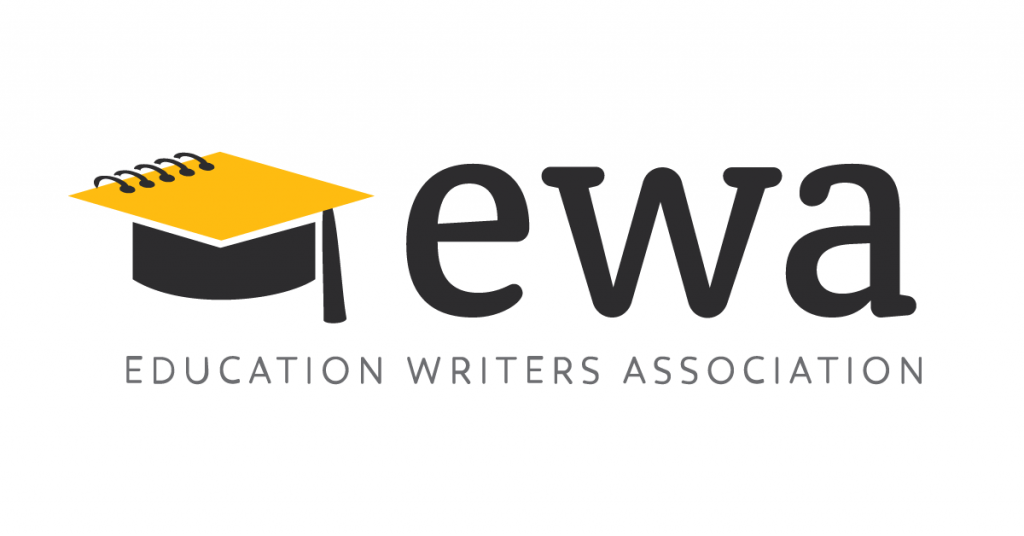
At the Education Writers Association National Seminar on June 2nd, hosted at Georgetown University in Washington, D.C., Marguerite Roza presented on new school spending reports emerging under the federal ESSA financial transparency requirement.
With New Data, School Finance Is Coming Out of the Dark Ages

In this blog and podcast, Marguerite Roza explains how a sleeper provision in the Every Student Succeeds Act (ESSA) will serve up a motherlode of new school-level financial data, offering an unprecedented opportunity to be better equipped to tackle some of education’s most pressing issues.
The Equity Problem in Teacher Pensions

This brief shows how high-minority schools receive fewer dollars in pension wealth than low-minority schools within the same district, and makes the case for pension dollars to be more transparent and included in discussions around K-12 spending equity.
Are public universities neglecting in-state students?

Marguerite Roza responds to an online “Room for Debate” conversation hosted by the New York Times, arguing that chasing after nonresident students threatens the very nature of public universities as institutions that serve the state.
The Productivity of Rural Schools

Remote rural districts are often more expensive and yield lower student outcomes than urban and suburban districts. Yet some rural districts generate higher-than-expected learning results without proportionately higher spending. Based on interviews with leaders in 30 rural remote districts, Marguerite Roza identifies six factors that make some districts “productivity superstars.”
Advancing System Productivity Webinar Series
Edunomics Lab, in partnership with Council of Chief State School Officers and the Building State Capacity and Productivity Center, convened a Community of Practice to support a group of leaders in all states interested in developing a state-specific framework and strategy set related to the SEA’s role in increasing productivity. This series of five webinars is designed to help Regional Comprehensive Centers support state education agency (SEA) leaders as they explore how they can better support districts and schools to operate in a more productive way.
Meeting the ESSA Financial Transparency Reporting Requirement

On February 9, 2017 nearly 100 state and district leaders representing 36 states met in Washington, D.C. to explore the opportunities and work ahead to meet the financial transparency reporting requirement in ESSA. Available presentations are linked.
Breaking tradition: A fixed-dollar pay raise strategy that benefits teachers and school districts

In this paper we examine both the degree to which pay systems for teachers are more heavily back-loaded than for many other professions and the ramifications of this steep salary curve for teachers, states and school districts.
Highly Productive Rural Districts: What is the Secret Sauce?

In this paper we identify some common themes that makes some remote rural districts “productivity superstars” and describe steps states can take to encourage and support district productivity.
Promoting Productivity: Lessons from Rural Schools
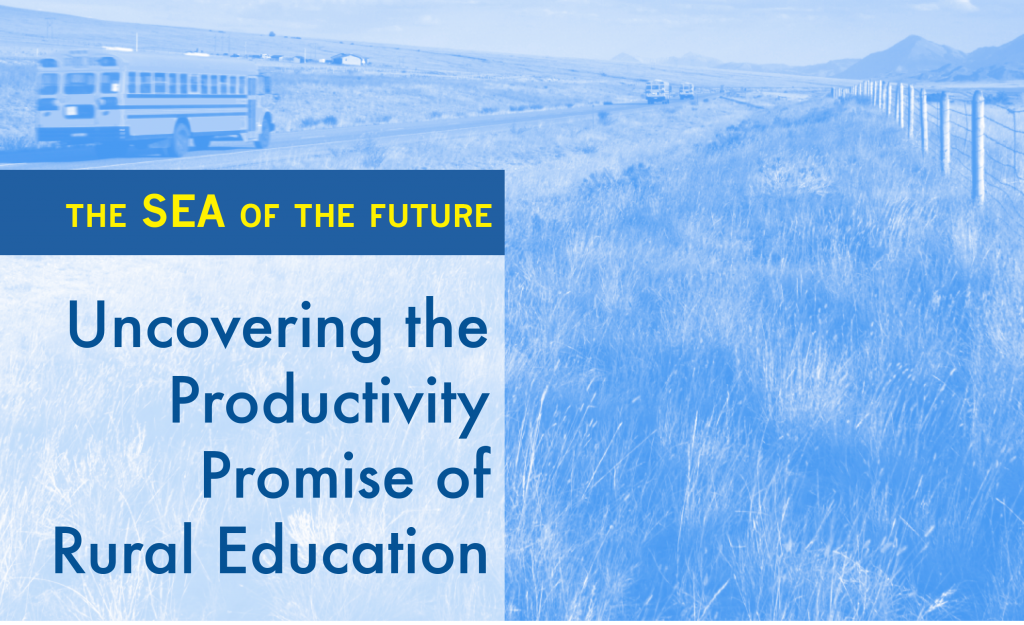
In this essay addresses the assumption that rural districts are less productive than their urban or suburban peers by discussing rural districts can “beat the odds” by increasing student results without increasing per-pupil expenditures.
Teachers’ Pensions and the Overgrazed Commons
Commentary by Marguerite Roza and Michael Podgursky on how big raises to teachers nearing retirement is a recipe for letting pension debt get out of control.
Title I: Time to Get It Right

In this brief on the landmark federal law’s 50th anniversary, we offer five key principles to help policymakers revise Title I so that it fulfills its promise of augmenting funding for poor students.
Innovation Amid Financial Scarcity: The Opportunity in Rural Schools

In this paper we explore spending and outcomes data of rural schools and highlight policy implications for states seeking improved outcomes for all their districts in the context of limited resources.
The Phantom Menace: Policies that Protect Districts from Declining or Low Enrollments, Drive Up Spending and Inhibit Adaptation
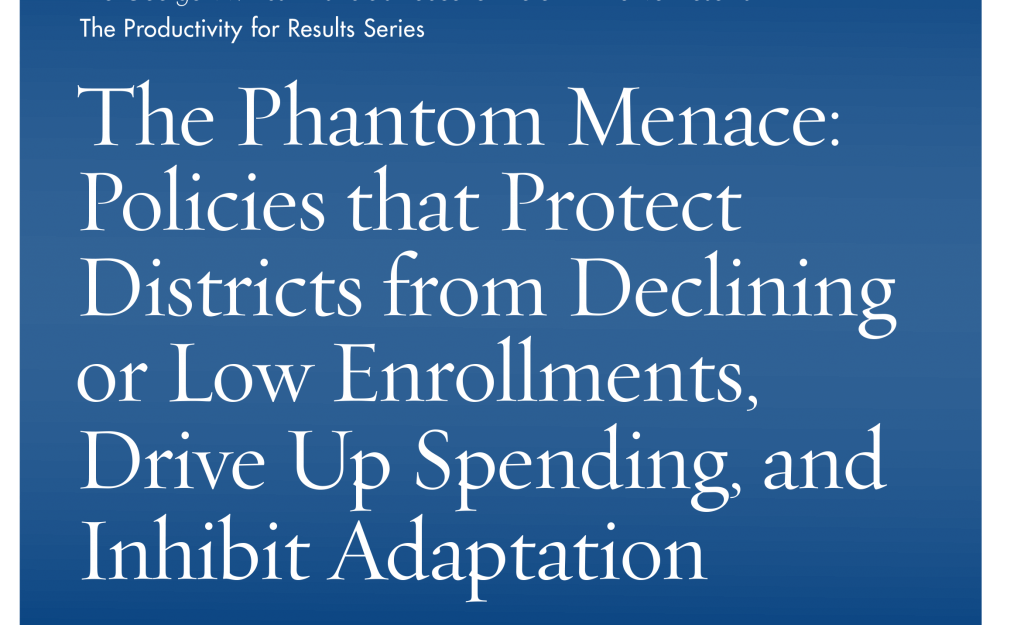
This paper examines the practice of states funding school districts for students who do not attend school there. Aimed at “protecting” districts from enrollment fluctuations, the practice drives up spending and inhibits adaptation.
How Late-Career Raises Drive Teacher-Pension Debt

In this paper we model the impacts of late-term raises on teacher pension obligations showing that on average each dollar raise triggers $10 to $16 in new taxpayer obligations and provide suggestions to mitigate such impacts while improving incentives for early and mid career teachers.
The Real Deal on K-12 Staffing

This analysis finds that staffing ratios across K-12 education have risen precipitously over several decades and, despite the impact of the Great Recession, remain at 2004 levels. A state-by-state comparison reveals large disparities across states.
Building SEA Productivity

In this presentation state education chiefs heard about a basic framework for leading the productivity challenge that includes building a productivity data infrastructure, prioritizing flexibility, aligning funds with students, incentivizing innovation, and leading the change.
A State Information System to Support Improvements in Productivity

In this paper, we discuss how states can (and why they should) track and share school-level outcomes relative to school-level spending in their online information systems. Some schools are far more productive than others—getting better student results for less money—yet states are not yet routinely identifying such schools.
Funding for Student’s Sake: How to Stop Financing Tomorrow’s Schools Based on Today’s Priorities
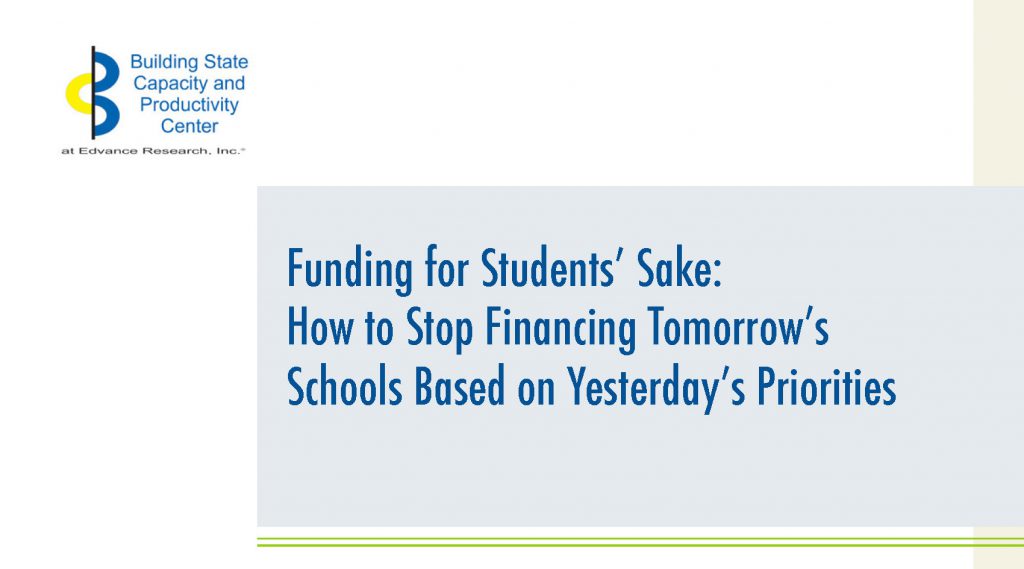
Most states make major changes in their allocation models only every two decades or so. In this paper, we explore how states can make the most of their redesign to get better outcomes for the money.
SEA of the Future: Building the Productivity Infrastructure

This publication introduces the “productivity infrastructure” the building blocks for an SEA committed to supporting productivity, innovation, and performance—from the state chief to the classroom.
Options for NY State in an Era of Constrained Resources

At a public symposium of the NY Education Reform Commission, Marguerite Roza presented on “Maximizing Resources for Student and School Success.”
The SEA of the Future: Prioritizing Productivity

In this volume of The SEA of the Future, Marguerite Roza co-authored two essays examining how state leaders, challenged with having to make decisions on how to use limited resources, are faced with an uneasy zero-sum game: every dollar they put into one program is a dollar not spent in another.
Teacher Retirement Benefits: Defining a More Active Role for SEAs and Their Chiefs

In this essay from The SEA of the Future Volume 2, Marguerite Roza and Michael Podgursky look in depth at the startling long-term costs of educator pension systems and the counterproductive employment incentives embedded in these systems.
Leveraging Productivity for Progress: An Imperative for States

In this essay published in The SEA of the Future Volume 2, Marguerite Roza makes the case for why productivity is essential to improving outcomes for students.
The High Price of Excess Credits

This brief examines the cost of extra credits earned by students in California, Georgia, and New York, and opportunities for state and university leaders to maximize degree attainment with constrained resources.
More Students, More Degrees, More Dollars

Cuts to state support for higher education have prompted some universities to raise tuition, admit more out-of-state students, and increase enrollment to close budget gaps. This analysis compares these three strategies in public flagship universities, first in terms of the relative magnitude needed to close a gap in state funds, and then in terms of the extent to which they contribute to degree production for students in their state.
Funding Phantom Students

This brief describes a common practice that inhibits both efficiency and productivity: funding students who do not actually attend school in funded districts and how this is often overlooked by state leaders.
How Current Education Governance Distorts Financial Decisionmaking

In this chapter, Roza assesses the strengths and weaknesses of what remains of the old in education governance, scrutinizes how traditional governance forms are changing, and suggests how governing arrangements might be further altered to produce better educational outcomes for children.
Are Residents Losing Their Edge in Public University Admissions? The Case at the University of Washington

This brief examines admissions data at the University of Washington to in order to quantify the effect on admissions standards for residents versus nonresidents, who typically pay higher tuitions.
Rethinking State Education Finance Toward Greater Productivity

This presentation framed how state legislators might think differently about their investment in education to maximize scarce state dollars and improve student achievement.
Stretching the School Dollar: A Brief for State Policymakers
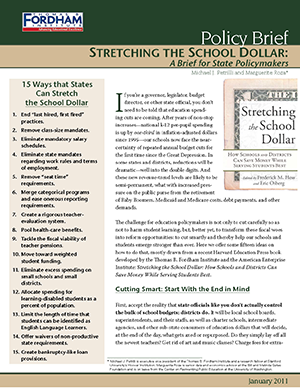
This policy brief lists fifteen concrete ways that states can “stretch the school dollar” in these difficult financial times.
A False Dilemma: Should Decisions About Education Resource Use Be Made at the State or Local Level?
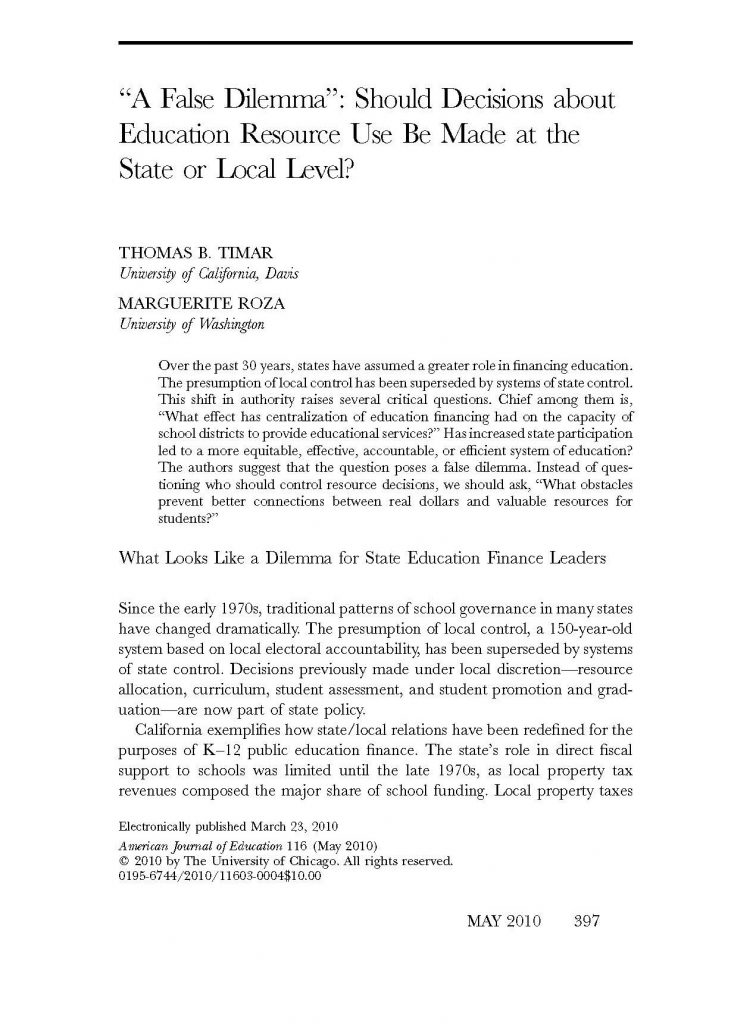
The shift in authority from the local to the state level raises several critical questions. In this paper, the authors suggest that the question should be “What obstacles prevent better connections between real dollars and valuable resources for students?”
Beyond Teacher Reassignments: Better Ways Districts Can Remedy Salary Inequities Across Schools

This brief demonstrates how, contrary to common worry, closing Title I’s “comparability provision” loophole would not force districts to mandatorily reassign teachers.
How Districts Shortchange Low-Income and Minority Students

Dr. Roza’s analysis demonstrates that, despite district bookkeeping practices that make funding across schools within the same district appear relatively comparable, substantially less money is spent in high-poverty and high-minority schools.

